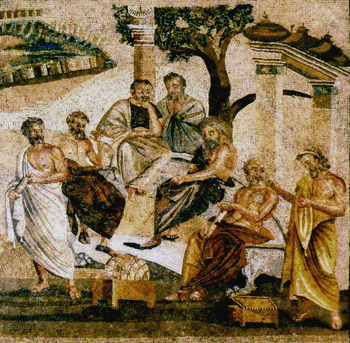This is the last of MarketCopywriter’s three-post series on copywriting and marketing with print collateral. Read the first post and second post.
A scholar feared emerging technology would destroy memory. He thought it would wipe out the culture’s rich oral tradition. It would weaken scholarship and dupe students into thinking they’d acquired wisdom—when they’d merely mastered rapid information recall.
What was the technology? Video games? The Internet? Google?
No. It was reading. The time was 300 BC. And the critical scholar was Plato.
Of course today we know reading didn’t destroy scholarship. It did, however, rearrange the organization of our brains, expand ways we think—and alter the evolution of our species.”
Reading and writing made knowledge portable, shareable and “viral”—and democratized culture and education.
And what does Plato’s technophobia have to do with print collateral marketing?
It illustrates my belief that digital—or any other—technology can’t and won’t replace tried and true cultural traditions or commercial practices.
Concepts and conventions may at first clash. But eventually they interweave, adapt and evolve into boundary-blurred hybrids.
Digital and print content strengthen your marketing mix.
As a copywriter, I still write a lot of print collateral for clients. From my vantage point, the digital revolution didn’t make print marketing lay down and die. Like Gloria Gaynor, print media survived. For lots of good reasons.
Brochures, Slim Jims and sales sheets remain a messaging media of choice for a surprising number of clients and customers.
When thoughtfully planned, well-written and attractively produced, collateral works. Hard.
Good brochures enhance image, support sales, drive traffic, generate leads and boost referrals and donations.
Trouble is, most brochures aren’t good. Most brochures are bad. Very bad.
Why most brochures fail
Collateral’s failure can’t be chalked up entirely to digital media dominance. The painful truth? Collateral has a bad rap because it’s usually ill-conceived and poorly produced.
It promises to build brand and boost your bottom line. But it doesn’t deliver.
Why? Chiefly because collateral creators fall into a handful of marketing missteps. I dub them the 7 Deadly Sins of Collateral Marketing.
As a mindful marketer, you must identify these selling sins—and avoid them like the plague.
The Brochure Bible shows you how.
Download The Brochure Bible now—free!
To help small business owners—and the marketers who support them—create great, hard-working collateral, I’ve written a free 44-page resource, The Brochure Bible, Your Alpha to Omega Guide to Creating Killer Collateral Brochures.
A start-to-finish guide to collateral content creation, The Brochure Bible…
- Explains the 7 Deadly Sins of Collateral Marketing—and how to avoid them.
- Helps you identify collateral’s place in your selling cycle.
- Pinpoints the type of brochure that works best for your company and brand strategy.
- Gives you practical tips on brochure design, copy structure and formatting.
- Provides persuasion pointers that help you get inside your customer’s head and heart.
- Delineates detailed step-by-step copywriting how-tos that make content creation easy.
![]()
Download your free, no-obligation copy of The Brochure Bible here.
Photo courtesy of Wikimedia


Nice one, Lorraine! It’s great to get a bit of highbrow into my day’s reading. Best regards, P. 🙂
Right, Paul–all this time we thought we were hired pens, but we’re really Classicists… Thanks for dropping in!
Bloom where you are planted.
People: Sorry about the comment spam. I’m taking care of it now.
Hi Lorraine:
Your lead in this post is excellent. I was a philosophy minor in college and still read Plato. (Now that I have gotten that geek confession off my chest! 🙂 Yet, I never saw that connection between Plato and his trepidation over “disruptive technology” of books — until now. You set up the lead beautifully . . . What is ironic is that we can read and study Plato’s works today (2300 years later) precisely because they were written.
Thanks for stopping by, Sean.
Yes, it is ironic that Plato’s thinking survives because it was captured in writing.
Something of a Luddite, I secretly believe Plato’s fears were partially founded. While writing preserved–and helped create–great artistic works, it also eroded traditional culture. E.g.: our ability to easily memorize and recite long poetic works.
Some note similar costs and benefits with digital culture. If you haven’t yet read it, you might enjoy Atlantic’s, Is Google Making us Stupid? http://www.theatlantic.com/doc/200807/google